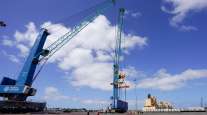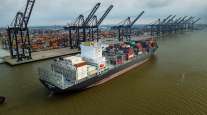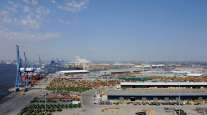Senior Reporter
East Coast Ports Continue to Gain Business Amid Concerns Over West Coast Labor Talks

[Stay on top of transportation news: Get TTNews in your inbox.]
Ongoing concern about labor and management talks regarding two separate contract negotiations and a slowing U.S. economy resulted in a big drop in container volume at two of the nation’s biggest ports on the Pacific Coast.
Year-over-year cargo numbers were down 25% at the Port of Los Angeles. In October, the port processed 678,429 20-foot-equivalent units compared with 902,643 a year ago. Through the first 10 months of 2022, Los Angeles officials say volume is down 6% from 2021’s record pace.
“With cargo owners bringing goods in early this year, our peak season was in June and July instead of September and October,” Port of Los Angeles Executive Director Gene Seroka said during a media briefing. “Additionally, cargo has shifted away from the West Coast as some shippers await the conclusion of labor contract negotiations. We’ll do everything in our power to get that cargo back because the best route between Asia and the United States is straight through the Port of Los Angeles.”

Seroka
In San Francisco, the International Longshore and Warehouse Union and the Pacific Maritime Association — the management group representing 29 ports and warehouse complexes on the West Coast — are engaged in negotiations to reach a new contract.
Meanwhile, a dispute over jurisdictional issues between unions at the Port of Seattle has bogged down the talks. The National Labor Relations Board is reviewing the matter.
ILWU has been working without a contract since June, and Seroka said uncertainty over the status of labor talks has led many shippers to move their cargo from the West Coast to East Coast to make sure it is processed.
The adjacent Port of Long Beach also saw a double-digit decline in TEU volume in October. Volume fell 16.7% to 658,428 containers compared with 789,716 year-over-year.
#POLB cargo eased up in October following reduced demand and a shift of imports, a development seen by Port officials as a normalization of the supply chain. Port workers moved 658,428 TEUs of cargo containers last month, down 16.6% from October 2021. https://t.co/YgizNnrTxo pic.twitter.com/tO539bmMws — Port of Long Beach (@portoflongbeach) November 11, 2022
“The supply chain is returning back to normal and cargo continues to move, so I am optimistic that store shelves will be stocked and goods will be available for delivery during the holiday season,” Port of Long Beach Executive Director Mario Cordero said.
While Los Angeles and Long Beach reported declines in October, the Port of Oakland bounced back, notching a 16.8% year-over-year increase in container volume. The port processed 202,487 containers compared with 173,310 in 2021.
“Although we anticipate that overall cargo will decline on the West Coast in the coming months, the recent uptick in volume at Oakland is welcome news, especially on the export side,” Port of Oakland Maritime Director Bryan Brandes said, noting that export cargo was up 4.8% year-over-year.
The Northwest Seaport Alliance, which operates the Seattle and Tacoma, Wash., facilities, processed 272,129 containers in October, a 13.6% decline compared with 314,801 in 2021.
2022 has continued to be a record-setting year for @Port_Houston. Hear from Executive Director Roger Guenther on how Port Houston is adjusting to the changing market by providing more yard space, more equipment, and more hours of service at rapid speed.https://t.co/VJ2R7HjuBc — Port Houston (@Port_Houston) November 3, 2022
Port Houston continued its strong year with another record for the month of October, processing 371,944 containers, a 13.2% rise from 328,486 in 2021.
For the year, volume is up 18% year-over-year, and the port easily passed the 3 million mark in October, moving 3,333,924 for the first 10 months.
On the East Coast, volume snapped back at Georgia’s Port of Savannah. The facility had its second-strongest month on record, processing 552,806 TEUs for a 9.3% increase over 505,347 a year earlier. October’s level also was up 26.7% from September, and the port is on track to easily exceed 2021’s record 5.6 million containers, likely by early December.

Lynch
“Customers continue to bring new or expanding business to the Port of Savannah, drawn by our global connectivity and the supply chain network that links Savannah to major U.S. markets,” GPA Executive Director Griff Lynch said. The Port Authority of New York and New Jersey usually is one month behind other ports. In September, that facility processed 842,219 containers, an 8% year-over-year increase from 780,782 a year ago.
Industry officials say the East Coast ports continue to gain volume because of the uncertainty over the West Coast labor negotiations, including the ongoing freight railroad talks.
The Port of Virginia nearly matched its October record, processing 318,452 TEUs compared with 318,482 in 2021.
South Carolina’s Port of Charleston complex also reported a strong October, handling 256,857 containers compared with 234,923 a year ago. For the past 13 months, the port has seen a significant increase in exports, moving more than 100,000 outbound containers.
The port complex last month said it handled three 1,200-foot ships simultaneously at its Wando Welch Terminal — a first for the 40-year-old container terminal that has been enhanced with big-ship capabilities and more cargo capacity.
“Our excellent SC Ports teammates and maritime partners seamlessly handled record cargo volumes in October,” South Carolina Ports CEO Barbara Melvin said.
Want more news? Listen to today's daily briefing below or go here for more info:




